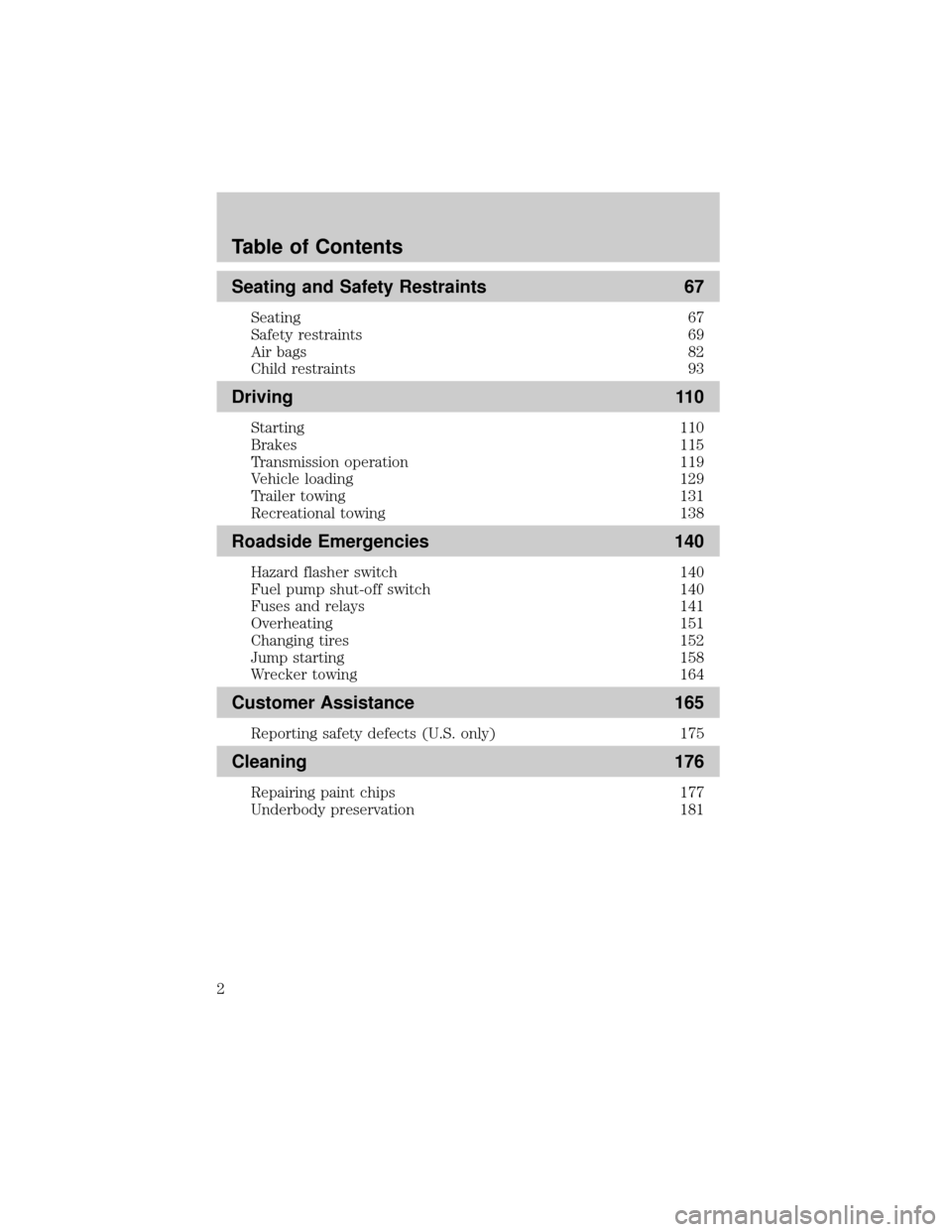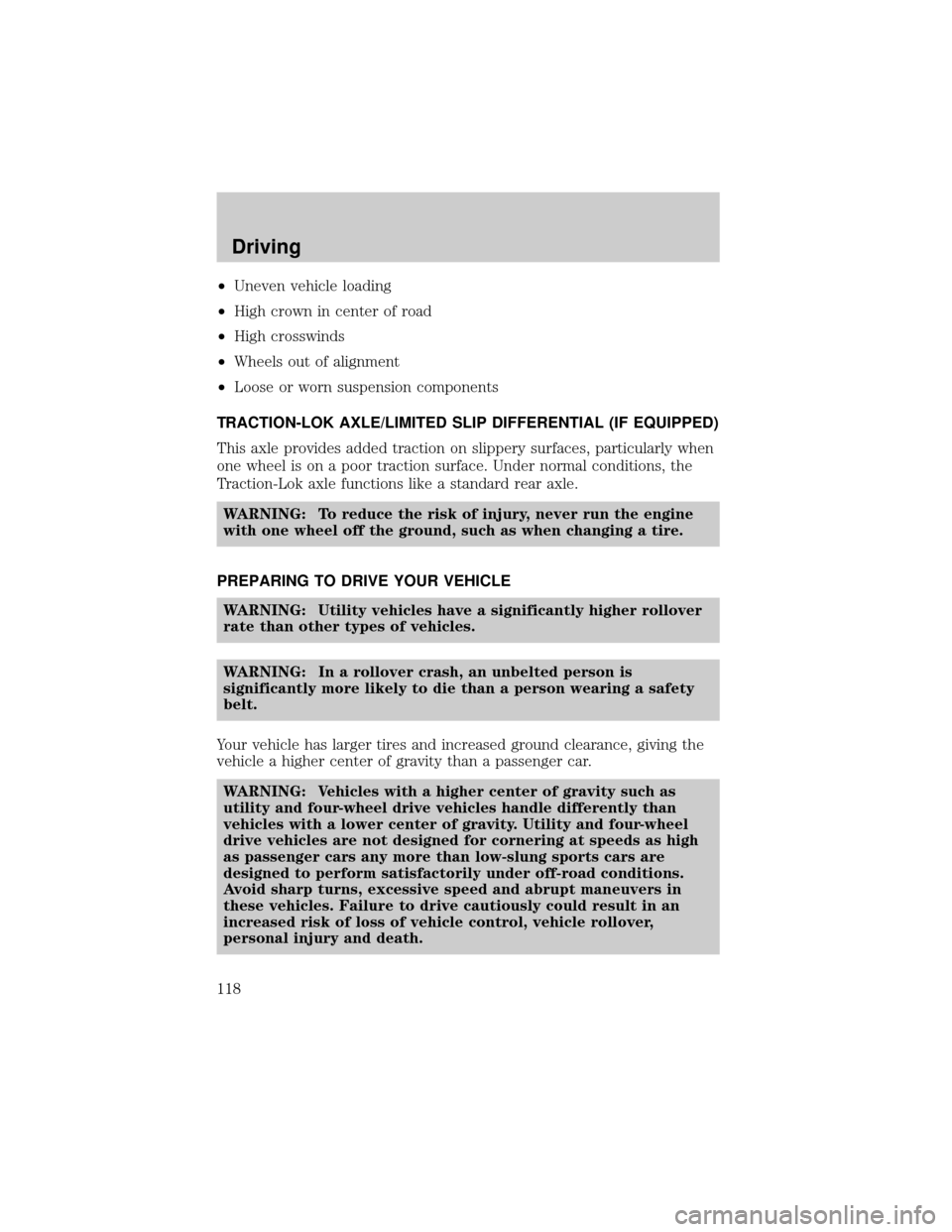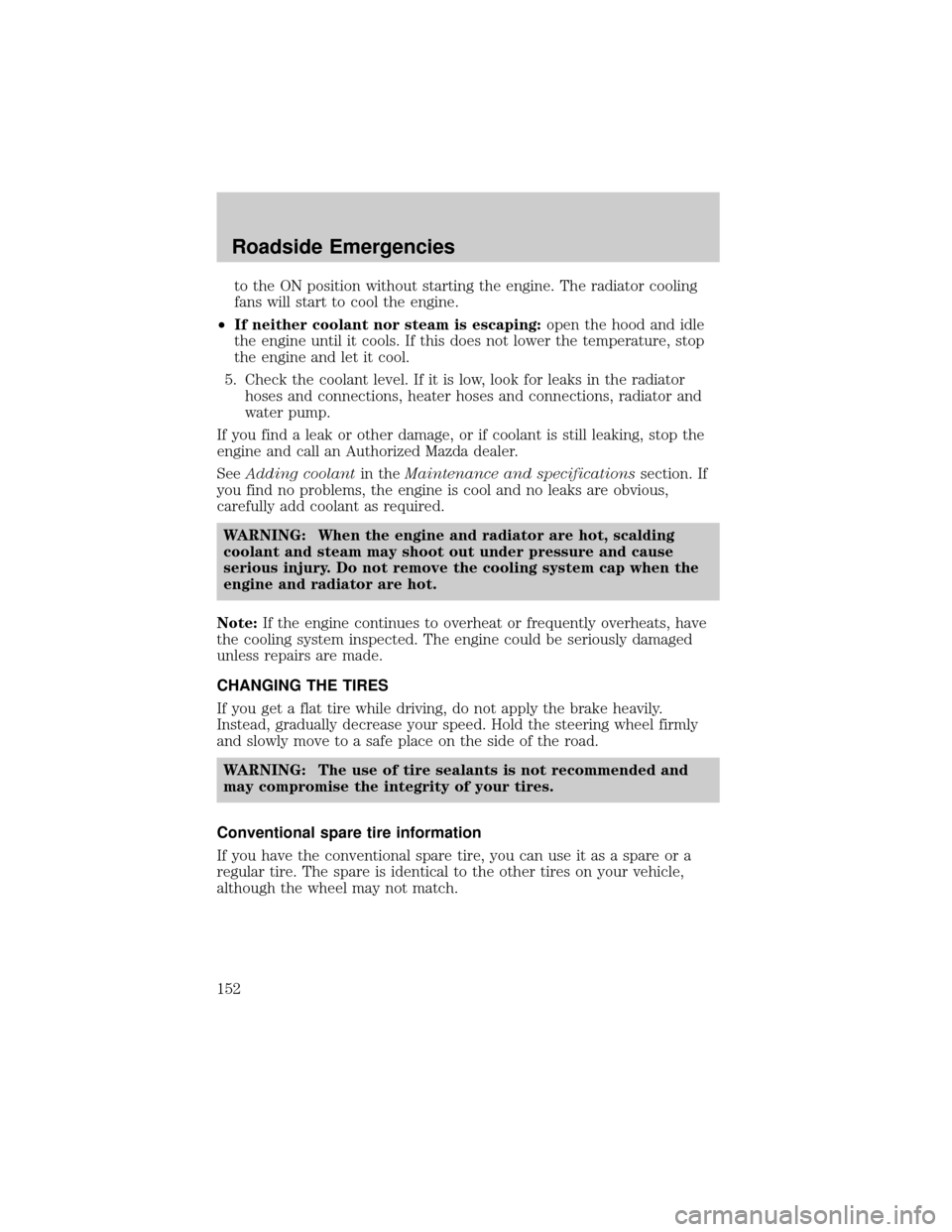changing tire MAZDA MODEL B2300 2003 Owners Manual (in English)
[x] Cancel search | Manufacturer: MAZDA, Model Year: 2003, Model line: MODEL B2300, Model: MAZDA MODEL B2300 2003Pages: 248, PDF Size: 2.71 MB
Page 2 of 248

Seating and Safety Restraints 67
Seating 67
Safety restraints 69
Air bags 82
Child restraints 93
Driving 110
Starting 110
Brakes 115
Transmission operation 119
Vehicle loading 129
Trailer towing 131
Recreational towing 138
Roadside Emergencies 140
Hazard flasher switch 140
Fuel pump shut-off switch 140
Fuses and relays 141
Overheating 151
Changing tires 152
Jump starting 158
Wrecker towing 164
Customer Assistance 165
Reporting safety defects (U.S. only) 175
Cleaning 176
Repairing paint chips 177
Underbody preservation 181
Table of Contents
2
Page 118 of 248

²Uneven vehicle loading
²High crown in center of road
²High crosswinds
²Wheels out of alignment
²Loose or worn suspension components
TRACTION-LOK AXLE/LIMITED SLIP DIFFERENTIAL (IF EQUIPPED)
This axle provides added traction on slippery surfaces, particularly when
one wheel is on a poor traction surface. Under normal conditions, the
Traction-Lok axle functions like a standard rear axle.
WARNING: To reduce the risk of injury, never run the engine
with one wheel off the ground, such as when changing a tire.
PREPARING TO DRIVE YOUR VEHICLE
WARNING: Utility vehicles have a significantly higher rollover
rate than other types of vehicles.
WARNING: In a rollover crash, an unbelted person is
significantly more likely to die than a person wearing a safety
belt.
Your vehicle has larger tires and increased ground clearance, giving the
vehicle a higher center of gravity than a passenger car.
WARNING: Vehicles with a higher center of gravity such as
utility and four-wheel drive vehicles handle differently than
vehicles with a lower center of gravity. Utility and four-wheel
drive vehicles are not designed for cornering at speeds as high
as passenger cars any more than low-slung sports cars are
designed to perform satisfactorily under off-road conditions.
Avoid sharp turns, excessive speed and abrupt maneuvers in
these vehicles. Failure to drive cautiously could result in an
increased risk of loss of vehicle control, vehicle rollover,
personal injury and death.
Driving
118
Page 152 of 248

to the ON position without starting the engine. The radiator cooling
fans will start to cool the engine.
²If neither coolant nor steam is escaping:open the hood and idle
the engine until it cools. If this does not lower the temperature, stop
the engine and let it cool.
5. Check the coolant level. If it is low, look for leaks in the radiator
hoses and connections, heater hoses and connections, radiator and
water pump.
If you find a leak or other damage, or if coolant is still leaking, stop the
engine and call an Authorized Mazda dealer.
SeeAdding coolantin theMaintenance and specificationssection. If
you find no problems, the engine is cool and no leaks are obvious,
carefully add coolant as required.
WARNING: When the engine and radiator are hot, scalding
coolant and steam may shoot out under pressure and cause
serious injury. Do not remove the cooling system cap when the
engine and radiator are hot.
Note:If the engine continues to overheat or frequently overheats, have
the cooling system inspected. The engine could be seriously damaged
unless repairs are made.
CHANGING THE TIRES
If you get a flat tire while driving, do not apply the brake heavily.
Instead, gradually decrease your speed. Hold the steering wheel firmly
and slowly move to a safe place on the side of the road.
WARNING: The use of tire sealants is not recommended and
may compromise the integrity of your tires.
Conventional spare tire information
If you have the conventional spare tire, you can use it as a spare or a
regular tire. The spare is identical to the other tires on your vehicle,
although the wheel may not match.
Roadside Emergencies
152
Page 156 of 248

3. Block the diagonally opposite
wheel.
4. Insert tapered end of the lug
wrench behind hub caps and
twist them off.
5. Loosen each wheel lug nut
one-half turn counterclockwise
but do not remove them until
the wheel is raised off the
ground.
6. Position the jack according to
the following guides and turn
the jack handle clockwise until the tire is a maximum of 25 mm
(1 inch) off the ground.
WARNING: To lessen the risk
of personal injury, do not put
any part of your body under
the vehicle while changing a
tire. Do not start the engine
when your vehicle is on the
jack. The jack is only meant
for changing the tire.
²Front
Roadside Emergencies
156
Page 240 of 248

A
ABS (see Brakes) .....................115
Air bag supplemental restraint
system ..........................................82
and child safety seats ..............84
description ................................82
disposal ......................................88
driver air bag ............................86
indicator light ...........................87
operation ...................................86
passenger air bag .....................86
passenger deactivation
switch ........................................88
Ambulance packages ....................7
Antifreeze
(see Engine coolant) ................204
Anti-lock brake system
(see Brakes) ......................115±116
Audio system
(see Radio) ................19, 21, 23, 27
Automatic transmission ............119
driving an automatic
overdrive .................................120
fluid, adding ............................223
fluid, checking ........................223
fluid, refill capacities ..............232
fluid, specification ..................236
Auxiliary power point .................49
Axle
lubricant specifications ..235±236
refill capacities ........................232
traction lok ..............................118
B
Battery .......................................202
acid, treating emergencies .....202
jumping a disabled battery ....158
maintenance-free ....................202servicing ..................................202
Bed extender ..............................57
BeltMinder ...................................77
Brakes ........................................115
anti-lock ...........................115±116
anti-lock brake system
(ABS) warning light ...............116
fluid, checking and adding ....221
fluid, refill capacities ..............232
fluid, specifications .........235±236
lubricant specifications ..235±236
parking ....................................116
shift interlock ..........................119
Break-in period .............................5
Bulbs ............................................40
C
Calculating load ........................131
Capacities for refilling fluids ....232
Cassette tape player .............21, 23
CD-single premium ...............19, 27
Cell phone warning ...................239
Certification Label ....................238
Changing a tire .........................152
Child safety restraints ................94
child safety belts ......................94
Child safety seats ........................97
attaching with tether straps ..102
in front seat ..............................99
in rear seat ................................99
LATCH .....................................106
tether anchorage hardware ...102
Cleaning your vehicle
engine compartment ..............177
exterior ............................177, 181
exterior lamps .........................179
Index
240
Page 244 of 248

S
Safety belts
(see Safety restraints) .........69±73
Safety defects, reporting ..........175
Safety restraints ....................69±73
belt minder ...............................77
cleaning the safety belts ..........80
extension assembly ..................76
for adults .............................70±72
for children .........................93±94
lap belt ......................................74
warning light and chime ..........76
Safety restraints - LATCH
anchors ......................................106
Safety restraints - tether
anchors ......................................102
Safety seats for children ............97
Seat belts
(see Safety restraints) ...............69
Seats ............................................67
child safety seats ......................97
Servicing your vehicle ..............190
Snowplowing .................................7
Spare tire
(see Changing the Tire) ...........152
Spark plugs, specifications .......236
Special notice
ambulance conversions ..............7
utility-type vehicles ....................7
Specification chart,
lubricants ...........................235±236
Speed control ..............................53
Starting a flex fuel vehicle .......113
Starting your
vehicle ........................110±111, 113
jump starting ..........................158Steering wheel
tilting .........................................48
T
Tether anchors ..........................102
Tires ...........................152, 227±228
changing ..........................152, 155
checking the pressure ............228
replacing ..................................230
rotating ....................................229
snow tires and chains ............231
tire grades ...............................228
treadwear ................................227
Towing .......................................131
recreational towing .................138
trailer towing ..........................131
wrecker ....................................164
Traction-lok rear axle ...............118
Transfer case
fluid checking .........................226
Transmission
automatic operation ...............119
fluid, checking and adding
(automatic) .............................223
fluid, checking and adding
(manual) .................................225
fluid, refill capacities ..............232
lubricant specifications ..235±236
manual operation ....................122
Turn signal ..................................40
V
Vehicle dimensions ...................236
Vehicle Identification Number
(VIN) ..........................................238
Vehicle loading ..........................129
camper bodies ........................139
Ventilating your vehicle ...........115
Index
244